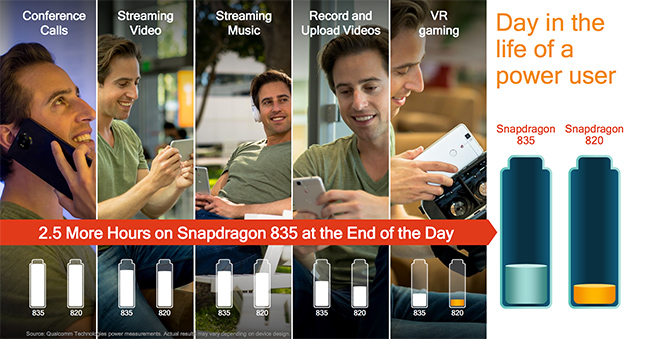The Qualcomm Snapdragon 835 Performance Preview
by Matt Humrick & Ryan Smith on March 22, 2017 4:30 AM EST- Posted in
- Smartphones
- Snapdragon
- Qualcomm
- Mobile
- SoCs
- Snapdragon 835
- Kryo
First Thoughts
Mobile SoCs are packed with specialized processors: CPU, GPU, high-performance DSP (compute), low-power DSP (sensor hub), modem DSP (signal processing), ISP (image processing), fixed-function blocks (video, audio), etc. And while all of these pieces contribute to the overall user experience, some of them are difficult to quantify. The CPU and GPU remain vital to device performance and battery life, so it’s still important to probe their capabilities.
Our initial testing shows that Snapdragon 835’s Kryo 280 CPU is an octa-core, big.LITTLE configuration with four semi-custom A73 “performance” cores and four semi-custom A53 “efficiency” cores. Kryo 280’s performance cores are pretty much equivalent to Kirin 960’s A73 cores in both integer and floating-point IPC, but comparing them to Snapdragon 820’s Kryo CPU shows mixed results: integer IPC improves but floating-point regresses.
In our limited system testing, the Snapdragon 835’s IPC gains outweigh its losses, providing better overall performance than the Snapdragon 820/821 phones. Unsurprisingly, the Snapdragon 835 MDP/S matched the performance of the Mate 9’s Kirin 960, which may not sound all that exciting, but considering our positive experience with the Mate 9, it’s certainly not bad either.
Qualcomm continues to push hard into VR/AR, not just with smartphones but stand-alone HMDs too. The high resolution and low latency requirements for these experiences suddenly make the GPU a bottleneck once again. The Snapdragon 835’s updated Adreno 540 GPU, through a combination of microarchitecture tweaks and a higher peak operating frequency, is another evolutionary step along the VR path, delivering a 25% peak performance boost over Snapdragon 820’s Adreno 530.
As noted earlier, all of these results came from pre-production hardware and software that’s under Qualcomm’s control, so performance could still go up or down once retail units begin shipping; however, based on these preliminary numbers and feature additions, the Snapdragon 835 looks like a solid evolutionary upgrade over the S820. The one glaring omission in this initial assessment, though, is power efficiency, which is critical to both battery life and sustained performance. The potential power savings from the move to 10nm and the CPU swap could have a larger impact on user experience than the small performance gains and new features.













128 Comments
View All Comments
lefty2 - Wednesday, March 22, 2017 - link
The iPhone 7 also scores a lot better in BaseMark OS II as well. At that stage we are looking at 3 benchmarks where iPhone trounces the best Android - although you can pick minor problems with each benchmark if you want - the overall picture is that the A10 performs better.joms_us - Wednesday, March 22, 2017 - link
A10 is better than SD821 by small margin in Basemark, SD835 will demolish it.lefty2 - Wednesday, March 22, 2017 - link
I didn't see SD821, but the A10 beats SD820 by a huge margin (almost double):http://www.anandtech.com/show/10685/the-iphone-7-a...
joms_us - Wednesday, March 22, 2017 - link
Check this one...http://www.gsmarena.com/oneplus_3t-review-1531p5.p...
Meteor2 - Wednesday, March 22, 2017 - link
I thought the whole point of Geekbench was that it used specific compilers for each ISA specifically so it *is* comparable.melgross - Wednesday, March 22, 2017 - link
Yes, and that's important. Too many benchmarks, in order to have some kind of equivelance, don't compile specifically to a particular chip. They don't support specific functions, so it may not be a comparable test. They must support, and properly, all of the features of a chip family.BurntMyBacon - Wednesday, March 22, 2017 - link
@lefty2: "So, yankeeDDL is correct, Apple's A10 trounces everything else (in single thread, which is the most important in a smartphone)."1) yankeeDDL did not make the single thread qualification that you made. Nor was any benchmark outside of this review mentioned. Therefore, yankeeDDL was not correct, regardless of the accuracy of your take on the situation.
2) You are using a single data point to disregard the entire benchmark suite here. Disregarding the perfectly legitimate reasons why the reviewers have chosen to leave geekbench out of the review suite, this still only gives the A10 one more win. Even then, you are purposefully leaving out the multi core data point, which puts the A10 only slightly ahead of Exynos 8890 in the Galaxy S7. I suspect, but can't confirm, that the A10 would lose to both the Kirin 960 and the Kryo 280. Yes, single threaded performance is important, but the Geekbench workload clearly isn't representative of all workloads.
Don't worry, the A10 isn't suddenly slow. It still ranks among the fastest SoCs on the market and is even still the top dog for certain senarios. Furthermore, platform optimizations and better use of APIs (see the javascript and basemark benchmarks) will likely hide any minor deficiencies until the A11(?) is released.
lefty2 - Wednesday, March 22, 2017 - link
I disregard multi threaded because most smartphone apps don't use multiple threads. Even for desktop PCs, single threaded performance is more important that multi threadedDrumsticks - Wednesday, March 22, 2017 - link
Didn't anandtech do an analysis of Android a while ago and find pretty much the exact opposite? And that was like a year ago so it can only have gotten better since then.lefty2 - Wednesday, March 22, 2017 - link
If they did, it must have been a very flawed analysis. Most people agree that single threaded performance is always the most important.